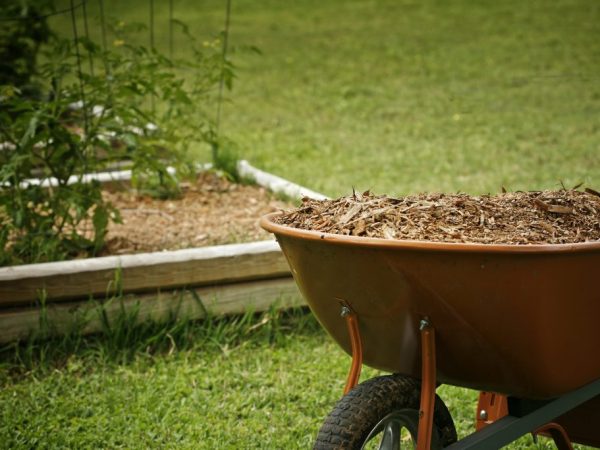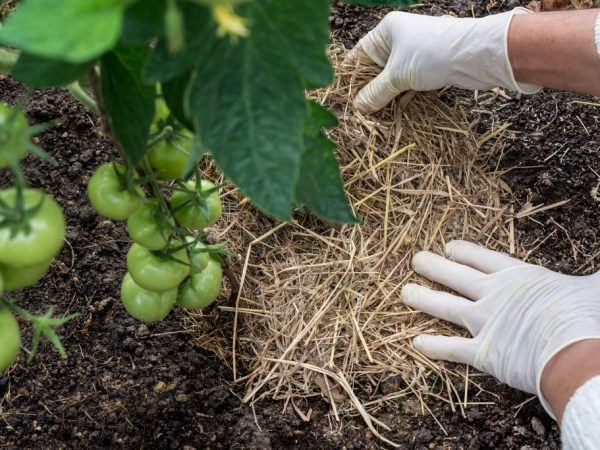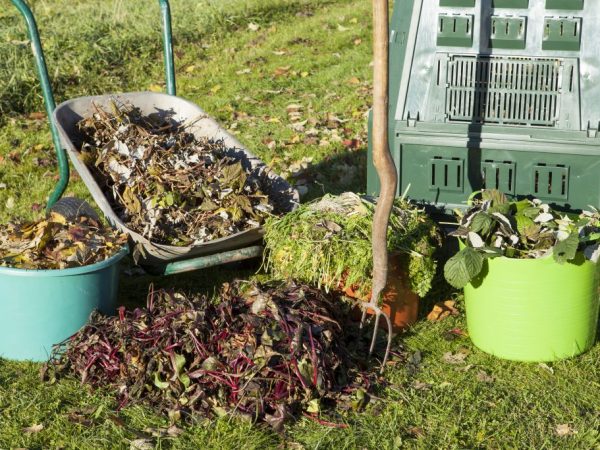How and what to carry out mulching tomatoes
Experienced gardeners often use modern agrotechnical technologies to increase yields when growing tomatoes, including mulching tomatoes. What and when to mulch tomatoes depends on whether they are grown in a greenhouse or planted in open ground. The table of contents of the article contains the essence and benefits of mulching, the main methods and timing of events.

Mulching tomatoes
What is the essence of mulching
Not all summer residents know what soil mulching for tomatoes is, how tomatoes are mulched in the open field and how to mulch tomatoes grown in a greenhouse. Mulching tomatoes is one of the agricultural methods to harvest early crops. When asked whether it is necessary to mulch tomatoes in a greenhouse and in an open garden, experienced summer residents give an affirmative answer. This is because mulch for tomatoes in the greenhouse and in the garden will protect them from overheating, weeds and maintain the necessary moisture in the soil layer.
Mulching tomatoes in a greenhouse or in the open field is carried out during the entire growing stage of development of a vegetable crop.
Mulching tomatoes in a greenhouse and in an open garden refers to one of the most effective manipulations in agricultural technology, which consists in covering the soil around the bushes using organic and artificial material. Under the influence of microorganisms contained in organic matter, after a while, loose natural material enters the process of humus, transforming into humus. The artificial material retains heat and protects against frost.
Mulch, which impedes the growth of weeds with its layer, retains water in the soil, which is important in dry seasons.
The benefits of such an event are similar to the positive results when carrying out agrotechnical work in agriculture, replacing:
- loosening the soil and weeding the soil to get rid of weeds,
- creating a protective layer for the root system of vegetable crops for the winter,
- carrying out preventive work in order to protect against bacteria and infectious plant diseases.
The benefits of mulch and its varieties
Covering a vegetable crop creates favorable conditions for development and growth, and its regular implementation is a guaranteed way to obtain the maximum possible yield indicators. This is made possible by the benefits of mulching, which is capable of:
- improve the quality of the structure of the soil layer,
- saturate the soil with microorganisms useful for vegetable crops, necessary for growth and fruiting,
- to reduce the loss of moisture necessary for the development of vegetables due to the creation of conditions for minimal evaporation from the surface of the earth,
- preserve the air permeability of the earth due to the prevention of soil caking after rain,
- to create protection of the lower layer of plant leaves from exposure to soil, thereby reducing the occurrence of fungal and infectious diseases such as rot, late blight and spotting.
In addition to the above properties useful for the growth and development of tomatoes, mulch protects the vegetable crop from the growth of weeds.
Varieties
For agrotechnical measures, you can use a variety of materials. At the same time, you can take natural or artificial mulch as mulch. To get rid of weeds quickly and safely for health and improve the quality characteristics of the soil, organic and inorganic means allow:
- organic mulch can be compost, grass cuttings, old foliage, tree bark, straw, needles,
- among inorganic products - unpainted paper and cardboard shelters, non-woven covering materials, plastic film.

Mulch will improve soil quality
We propose to consider all the varieties and note each of the advantages and disadvantages.
Inorganic species
For inorganic materials for mulching vegetable crops, reviews of gardeners note both advantages and disadvantages.
Film
Among the advantages of covering the beds with plastic wrap, one should note its affordability and ease of use. The service life for such a covering material is at least a year. It is an excellent yield when an automated drip irrigation system is installed.
For the southern regions, use light shades of the film, and for early harvests in the northern regions, use dark shades.
Among the disadvantages of choosing a film, mention should be made of poor ventilation, which leads to the root of the vegetable crop and causes the formation of fungi and bacteria.
Lay the film material on the beds with the planted vegetables after preliminary preparation, when organic groundbaits are inserted into the holes. The edges of the film laid on top of the ground are fixed with a weight. Cross-shaped cuts are made in the film, tomato bushes are planted in them.
Non-woven materials
Non-woven covering fabric helps to protect tomatoes from frost by insulating the roots. It belongs to the expensive types of mulch for tomatoes, but the period of effectiveness reaches up to five gardening seasons. Black material should be laid on top of the soil, and transparent material is intended for covering the bushes directly. Possessing good light transmission due to its porosity, the material perfectly permeates moisture and air and protects from sunlight.
Paper and cardboard materials
Available unpainted paper and cardboard with good efficiency, unfortunately, quickly get wet and become unusable, and with excessive moisture they become moldy and serve as a breeding ground for slugs.
A newspaper is not suitable for mulching tomatoes, since the lead in the printed rift is a harmful carcinogen for plants.
When using paper and cardboard, do not forget to regularly turn the material over and tedding. At the end of the gardening season, the cardboard is removed into compost pits. With paper and cardboard flooring, materials are pre-shredded.
Organic tricks

Compost must be mixed with sawdust before use.
Among organic products, there are many that have won the approval of gardeners. You can mulch tomatoes with cutted dried grass, use coconut fibers as a material or shavings, usually used as filler in mattresses, you can take compost and peat for covering, as well as sawdust and needles.
Hay and straw
Formed from hay or straw, mulch acts as an excellent covering organic material with thermal insulation qualities. Mulching tomatoes with grass and straw will protect against weeds and frost and provide a high yield of tomatoes grown in the greenhouse or outdoors.
Among the main disadvantages of hay or straw mulch laid out in the planting zones of tomato bushes, gardeners' reviews indicate the attraction of rodents and insects to the bushes, which spoil the stems and roots of plants. Mulching tomatoes with grass leads to the fact that animals begin to arrange nesting places in straw and hay.
Compost
Experienced gardeners have found compost to be the most suitable organic material. The only thing they advise when using it is caution and compliance with standards, since the compost contains many mineral elements, which can lead to oversaturation of the soil with them. When overfeeding a vegetable crop, tomatoes can grow, which adversely affects the harvest.
Even the unaesthetic appearance of compost does not stop summer residents from using it in mulching tomatoes.
Among the disadvantages, many indicate the presence of parasites and weed seeds in immature compost, therefore, when choosing a compost material, special attention should be paid to its quality. Often, for the purpose of mulching tomatoes, it is not used in its pure form, but is mixed with sawdust or grass.
Sawdust, bark and needles
Often, tree bark, needles and sawdust are not used for mulching tomatoes, but as a covering material for plant protection for the winter. However, if you nevertheless decide to use woody organic material as mulch and mulch tomatoes with sawdust, it is recommended to keep it for a year so that aged, it will bring the greatest value to the plants and does not oxidize the soil.
Terms and rules
The basic rule of mulching tomatoes is to prevent overheating of the soil layer. However, you should not take up activities until the ground has warmed up to 15 ', since the mulched cold soil will remain cold.
Before mulching, the soil layer is loosened, weeds are removed, and only then an organic layer is applied, leaving space near the stem for irrigation. The timing of when to mulch tomatoes depends on where the vegetable is planted.
In the greenhouse
To obtain a high yield of tomatoes in a short time, mulch tomatoes in a greenhouse, where there are additional sources of artificial heating, begins immediately after planting tomato seedlings. This will help to maintain the required moisture content, act as fertilizer for the earth and protect against weeds.
When there is no artificial heating in greenhouse conditions, they are in no hurry to mulch tomatoes in the greenhouse. It is required to wait until the soil warms up before mulching the tomato, when frosts are no longer observed at night. Otherwise, a tomato mulch that does not allow the sun to pass through will lead to the death of plants.
In the open field
Mulching tomatoes in the open field is carried out after the seedlings have taken root, and the soil has warmed up enough.


